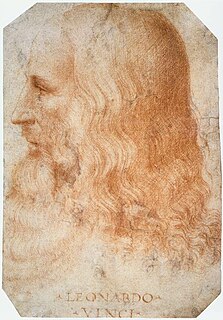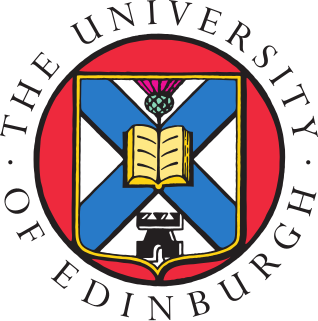
Andrea del Verrocchio, born Andrea di Michele di Francesco de' Cioni, was an Italian painter, sculptor, and goldsmith who was a master of an important workshop in Florence. He apparently became known as Verrocchio after the surname of his master, a goldsmith. Few paintings are attributed to him with certainty, but a number of important painters were trained at his workshop. His pupils included Leonardo da Vinci, Pietro Perugino and Lorenzo di Credi. His greatest importance was as a sculptor and his last work, the Equestrian statue of Bartolomeo Colleoni in Venice, is generally accepted as a masterpiece.

Giambologna — — was a Flemish sculptor based in Italy, celebrated for his marble and bronze statuary in a late Renaissance or Mannerist style.

An equestrian statue is a statue of a rider mounted on a horse, from the Latin "eques", meaning "knight", deriving from "equus", meaning "horse". A statue of a riderless horse is strictly an "equine statue". A full-sized equestrian statue is a difficult and expensive object for any culture to produce, and figures have typically been portraits of rulers or, more recently, military commanders.
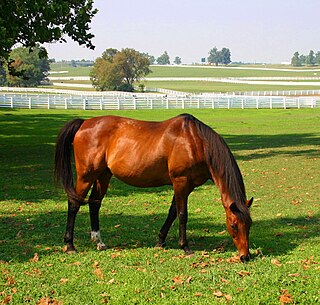
Kentucky Horse Park is a working horse farm and an educational theme park opened in 1978 in Lexington, Kentucky. It is located off Kentucky State Highway 1973 and Interstate 75, at Exit 120, in northern Fayette County in the United States. The equestrian facility is a 1,224-acre (4.95 km2) park dedicated to "man's relationship with the horse." Open to the public, the park has a twice daily Horses of the World Show, showcasing both common and rare horses from around the globe. The horses are ridden in authentic costume. Each year the park is host to a number of special events and horse shows.
The Breeders' Cup Turf is a Weight for Age Thoroughbred horse race on turf for three-year-olds and up. It is held annually at a different racetrack in the United States or Canada as part of the Breeders' Cup World Championships. The race's current title sponsor is Longines.
The Breeders' Cup Filly & Mare Turf is a Weight for Age Thoroughbred horse race on turf for fillies and mares, three years old and up. It is held annually at a different racetrack in the United States as part of the Breeders' Cup World Championships.
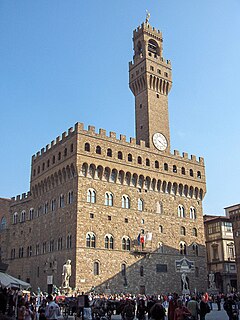
The Palazzo Vecchio is the town hall of Florence, Italy. It overlooks the Piazza della Signoria with its copy of Michelangelo's David statue as well as the gallery of statues in the adjacent Loggia dei Lanzi.
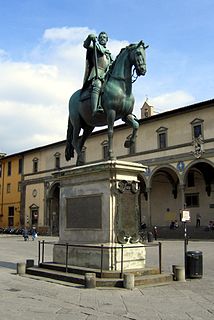
Pietro Tacca was an Italian sculptor, who was the chief pupil and follower of Giambologna. Tacca began in a Mannerist style and worked in the Baroque style during his maturity.
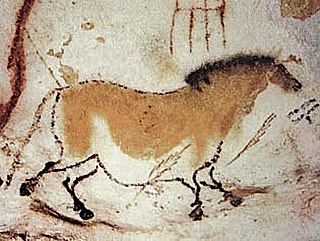
Horses have appeared in works of art throughout history, frequently as depictions of the horse in battle. The horse appears less frequently in modern art partly because the horse is no longer significant either as a mode of transportation or as an implement of war. Most modern representations are of famous contemporary horses, artwork associated with horse racing, or artwork associated with the historic cowboy or Native American tradition of the American west. In the United Kingdom depictions of fox hunting and nostalgic rural scenes involving horses continue to be made.
The decade of the 1490s in art involved some significant events.

Rick Rockefeller-Silvia is an equestrian athlete, equine breeder and former model.

Leonardo's Horse is a sculpture that was commissioned of Leonardo da Vinci in 1482 by Duke of Milan Ludovico il Moro, but not completed. It was intended to be the largest equestrian statue in the world, a monument to the duke's father Francesco. Leonardo did extensive preparatory work for it, but produced only a clay model, which was destroyed by French soldiers when they invaded Milan in 1499, interrupting the project. About five centuries later, Leonardo's surviving design materials were used as the basis for sculptures intended to bring the project to fruition.

The Kentucky Derby Trophy is a set of four trophies that are awarded to the winning connections of America's most famous race: the grade one $2,000,000 Kentucky Derby. The owner receives a gold trophy while the trainer, the jockey and the breeder win a silver half size replica of the main gold trophy. The trophy itself has been run for since the 50th running of the Kentucky Derby in 1924. Churchill Downs Race Course of Louisville, Kentucky has annually presented a gold trophy to the winning owner of the famed "Run for the Roses."
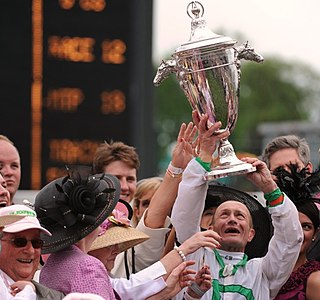
The Kentucky Oaks Trophy is a ceremonial trophy which is presented annually to the winner of the Kentucky Oaks horse race. Since the Kentucky Oaks is run on the Friday preceding the Kentucky Derby, the trophy presentation occurs on Friday evening, the evening before the Derby.
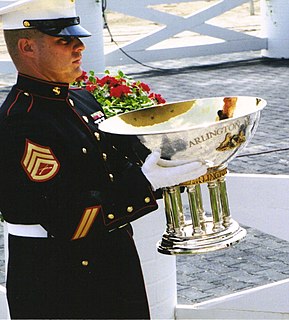
Each year the perpetual "Arlington Million Trophy" is presented to the winners of the Arlington Million in a national televised award ceremony. The Arlington Million Trophy is one that was commissioned in 1984 and stays on display at Arlington Park in Arlington Heights, Illinois year round. Arlington Park is owned by Churchill Downs Incorporated and the parent company lists the Arlington Million as one the country's most important races behind the Kentucky Derby and the Kentucky Oaks. The names of the horse and the connections are included in the display.

The Fountain of Neptune is a fountain in Florence, Italy, situated on the Piazza della Signoria, in front of the Palazzo Vecchio. Made of marble and bronze, the fountain was commissioned in 1565 and designed by Baccio Bandinelli. It is the work of the sculptor Bartolomeo Ammannati with some elements created by collaborators. For example, the bronze sea-horses are the work of Giovanni da Bologna, often called Giambologna.

Horse and Rider is a beeswax sculpture depicting a rider on a horse, attributed to Leonardo da Vinci c. 1508–1511. It was intended to be used as a model for a life-size sculpture, commissioned by Charles II d'Amboise, French Governor of Milan from 1503–1511. Charles II d'Amboise died in 1511, Leonardo died in 1519 and the monument to d'Amboise was never completed nor cast in bronze.





